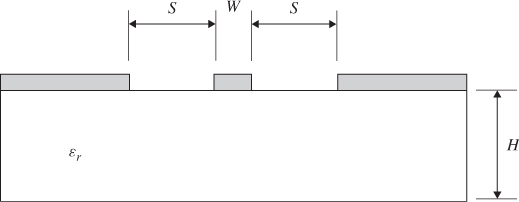Appendix G
Coplanar Waveguide (CPW)
In a coplanar waveguide (CPW) structure, metalization is present only on top of a dielectric slab. Impedance is controlled by the separation of metallic traces and not by substrate thickness. This can be advantageous, especially when making connections at high frequencies.
The cross section of a classic CPW is shown in Figure G.1. By ‘classic’ we mean that no ground plane is present. CPW structures on a grounded dielectric slab also exist.
Figure G.1 Cross section of a classic Coplanar Waveguide (CPW) structure.

The characteristic impedance, Z0, may be calculated as [1]
where
G.2 
and
G.3 ![]()
G.4 
In the above, K is the complete elliptic integral of the first kind and ![]() .
.
The ratio of complete elliptic functions in equation (G.1) may be approximated by [2]
G.5
References
1. G. Ghione and C. Naldi, ‘Analytical Formulas for Coplanar Lines in Hybrid and ...


